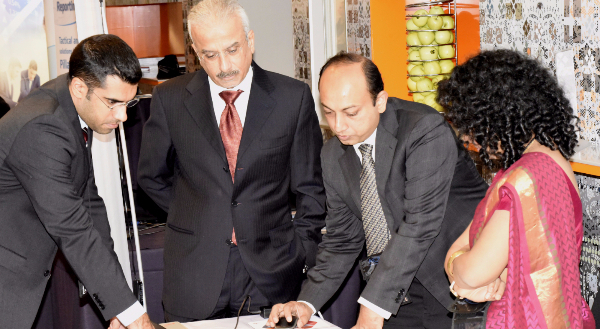XBRL International’s most awaited event of the year, #XBRL2015, was held last week in Copenhagen. For anyone concerned with Business Reporting, the event, themed Business Reporting 360° this year, must have been a treat.
Attended by industry experts, members of XII, regulators, policymakers, and professionals from various walks of IT, finance, and accounting, the 3-day event held from September 8-10, covered topics across different aspects of reporting, making it a 360° event in the true sense of the word. The attendees discussed aspects of business reporting from XBRL implementation lifecycles to best practices; from CRD IV implementation to Solvency II reporting. There were great insights on how businesses can use XBRL data, and also how government agencies like the Danish Business Authority have completely mandated XBRL. The sessions were interesting and covered structured data topics from creation to collection to consumption. This post is a recap of the week for those who missed the event.
The event started with a keynote discussion with Mr. John Turner, CEO, of XII, who helped attendees realize the real worth of data available on-demand. He talked about what’s next for business reporting in general and for the XBRL consortium.
The goal of the XII is to enhance transparency, accuracy, and access to financial and performance information across the world. – John Turner, CEO, XBRL International
Charlotte Jepsen, CEO of, the Association of Danish Auditors (FSR – danske revisor), then spoke of how XBRL has changed day-to-day reporting business in Denmark. This is a project that covers over 200,000 companies, some 1500 of which are IFRS filers and for which data is now freely available to the public. Charlotte concluded by saying:
XBRL has the power to perform – use it. – Charlotte Jepsen
Ms. Annika Branstrom, Director General at the Companies Registration Office in Sweden (Bolagsverket), then shared the success story of another successful XBRL implementation. The Swedish Standards Institute has approved XBRL as a national standard for electronic reporting and the exchange of financial information between organizations in the country. Annika Branstrom shared the problems they faced in the implementation specifically related to coordination between agencies and cascaded the message on the importance of collaboration in reporting.
Collaboration is on the rise. – Ms. Annika Branstrom
While the first day focused on implementations, days 2 and 3 revolved mainly around real-time implementation issues, practical discussions, and the future use of XBRL data by enterprises and governments at large.
Day 2 kicked off with a keynote from Adam Farkas, ED, EBA on CRD IV implementation which includes COREP and FINREP reporting. Adam, who is considered to be an authority on European banking regulations, propagated the need for transparency in the Banking sector by making consistent banking data available. He believes that though banks are heavily burdened by new reporting changes, flexibility, and communication will help in the long run. Adam delivered a simple yet powerful presentation on the complex and comprehensive reporting framework of the EU Banking system.
The last day of the conference was more interactive and about XBRL applications in enterprise reporting. The XBRL Taxonomy Leader at Brazil National Treasury, Mr. Bruno Simoes was very upbeat about #XBRLGL. He considers this to be the next wave of deep XBRL implementation having a cascading effect across the regulatory reporting system. XBRL GL focuses on the use of XBRL within the enterprise – not just the XBRL data generated to file with regulators, but also to support key activities like management reporting, KPI dashboards, data monitoring, and auditing. He opined:
#XBRLGL could be the “volcanic explosion” that can connect islands. – Mr. Bruno Simoes
David Shaw, FASB (Financial Accounting Standards Board) also presented the experience of the FASB’s Dimensions Working Group followed by a discussion on taxonomy extensions by Andromeda Wood, IASB ( International Accounting Standards Board). Later, she also conducted the Implementation Best Practices Workshop in association with Revathy Ramanan, a member of the XBRL International Best Practices Board and XII Guidance Task Force. The idea was to discuss the importance of understanding the best practices of the XBRL taxonomy, before going ahead with any full-fledged implementation.
XBRL specifications are generic; it takes experience to customize them to your reporting environment. – Revathy Ramanan
Figure 1: IRIS’ Shailesh Gupta ( 3rd from left) and Revathy Ramanan at XBRL2015
The “Quickfire” software demos at the end of the day, stole the show by becoming one of the more crowded sessions of the entire conference. Shailesh Gupta, Vice President at IRIS Business Services Limited showcased the possibilities of marrying technology with XBRL. Discussing the language proposition of XBRL, Shailesh showed the capabilities that enterprise reporting can develop by clubbing the right technology with XBRL.
The demonstration showcased how XBRL data not only comes as power in the hands of the regulators but also has immense possibilities when placed in the hands of business users.
There was another impromptu session for business registrars chaired by Mr. John Turner. IRIS demonstrated its rich data platform where Shailesh Gupta, demonstrated XBRL data consumption by comparing documents across several European countries and also showcasing automated analytics.
All in all, the event was a successful one with, knowledge, best practices,, and future possibilities of structured data being shared among the attendees.


